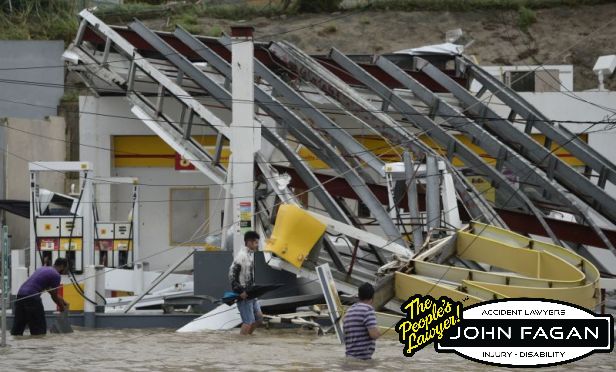People walk next to a gas station flooded and damaged by the impact of Hurricane Maria, which hit the eastern region of the island, in Humacao, Puerto Rico, Wednesday, September 20, 2017. (
As Hurricane Florence’s destructive winds approach the East Coast, now is the time to firm up your hurricane preparedness plan and take action.
Whether it be hurricanes in the Atlantic Ocean, typhoons in the Pacific Ocean, cyclones in the Southwest Pacific and Indian oceans or even winter storms in Europe, wind can have a devastating effect on your business.
While property damage and business interruption may be covered by the insurance policy, the loss of business cannot be easily recovered. The total loss caused by wind can cripple an organization.
Adequate preparation before a storm arrives can help you minimize the loss caused by a windstorm.
Allianz Risk Consulting has provided a checklist of what to do before, during and after a windstorm to help minimize the damage that may occur.
We’ve chosen 11 things you should do to prepare for a storm:
1. Develop a written windstorm emergency plan
Your emergency plan should include assigned organization roles and responsibilities with training provided at least annually.
Designate one person to monitor the status and location of the windstorm. Assemble emergency supplies and equipment (plastic tarps, mops, squeegees, emergency lighting, battery operated radio, tape for windows, lumber and nails) in a safe location for easy retrieval.
Maintain a list of key vendors, contractors and salvage services. Also, keep a business continuity plan (reviewed and updated regularly) for restoring operations after the event.
2. Inspect and repair roof
Inspect roof for problems with loose roof covering, loose flashing, edging strips and accessories, blocked or loose drains, gutters or downspouts, as well as inadequately secured equipment, signs, stacks, roof ventilators and repair or secure as needed.
Anchor large equipment, such as cranes and drag lines, in accordance with manufacturer’s guidelines.
3. Secure the outside of your property
Fasten down loose outdoor equipment, machinery, stock and other debris, or move it indoors.
Outdoor structures, such as trailers, should be properly anchored. Secure storage of flammable liquid containers or move them to a sheltered area (never into main facility areas).
Identify and consider removing any large trees or limbs that could fall and damage buildings, outdoor equipment, power lines, etc.
4. Protect windows and doors
Protect windows and doors by attaching pre-fitted windstorm shutters or plywood. Repair weak latches and hardware on doors and windows, and install steel bars in pre-installed metal brackets on the inside of exterior roll-up doors.
5. Fill fuel tanks
Make sure fuel tanks for generators, fire pumps, as well as company-owned vehicles are filled up. Also, fill above-ground tanks to capacity with product or water to prevent wind damage.
6. Clean drains and catch basins
Debris washed into storm drains can travel through pipes and get into lakes, rivers, streams and the ocean. Litter and leaves can also clog drains causing backups, which could result in flooding.
7. Protect computers, stock and machinery and equipment
All of these things can be damaged by water. Protect them with plastic tarps or waterproof covers. Backup all important computer data and store in a safe location.
8. Take note of what chemicals you have stored
Isolate, neutralize or remove from the site any chemicals that can react violently with each other. Certain combined chemicals can produce potentially toxic vapors that can be very dangerous, even deadly. Others may react violently to cause chemical burns.
9. Prepare for flooding
Relocate important equipment, stock and records to higher elevations not subject to flooding.
Cover equipment and stock that cannot be relocated with plastic tarps or store on pallets. Install back-flow prevention devices in sewer and drain lines to prevent floodwater from backing up into buildings.
Place sandbags at vulnerable building openings and around critical outdoor equipment subject to flooding. If there is imminent danger of flooding, shut off the building’s electrical power. Note: Power to electric motor-driven fire pumps should remain in service.
10. Be prepared to shut down operations
Shut off processes and equipment following your own established procedures. Shut off all flammable and combustible liquid and gas lines at their source to prevent discharge from broken piping. Enforce “no smoking” and “no cutting or welding” rules. Protect or shut off other possible flame sources.
11. Check your insurance policy
Consider things such as the type of coverage, as well as your level of coverage, and ensure that your insurance policy provides coverage for the types of events specific to your location.
These may include: flash floods, storm water runoff, landslips (or landslides) and damage to properties by trees. Discuss this with your insurance agent prior to the storm.






